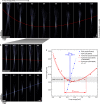An achromatic X-ray lens
- PMID: 35288546
- PMCID: PMC8921332
- DOI: 10.1038/s41467-022-28902-8
An achromatic X-ray lens
Abstract
Diffractive and refractive optical elements have become an integral part of most high-resolution X-ray microscopes. However, they suffer from inherent chromatic aberration. This has to date restricted their use to narrow-bandwidth radiation, essentially limiting such high-resolution X-ray microscopes to high-brightness synchrotron sources. Similar to visible light optics, one way to tackle chromatic aberration is by combining a focusing and a defocusing optic with different dispersive powers. Here, we present the first successful experimental realisation of an X-ray achromat, consisting of a focusing diffractive Fresnel zone plate (FZP) and a defocusing refractive lens (RL). Using scanning transmission X-ray microscopy (STXM) and ptychography, we demonstrate sub-micrometre achromatic focusing over a wide energy range without any focal adjustment. This type of X-ray achromat will overcome previous limitations set by the chromatic aberration of diffractive and refractive optics and paves the way for new applications in spectroscopy and microscopy at broadband X-ray tube sources.
© 2022. The Author(s).
Conflict of interest statement
A.K. is an employee of XRnanotech GmbH. The remaining authors declare no competing interests.
Figures




References
-
- Schroer C, Lengeler B. X-Ray Optics. New York: Springer New York; 2007.
-
- Salditt, T. & Osterhoff, M. X-ray Focusing and Optics. (Springer International Publishing, Cham, 2020).
-
- Jacobsen, C. X-ray Microscopy, 199–240. Chapter 5: X-Ray Focusing Optics (Cambridge University Press, Cambridge, 2019).
-
- Wolter H. Spiegelsysteme streifenden Einfalls als abbildende Optiken für Röntgenstrahlen. Ann. Phys. 1952;445:94–114. doi: 10.1002/andp.19524450108. - DOI
Grants and funding
LinkOut - more resources
Full Text Sources

